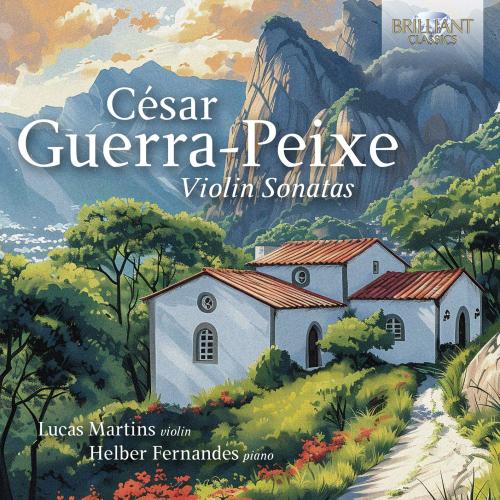
Guerra-Peixe: Violin Sonatas Lucas Martins & Helber Fernandes Ribeiro
Album info
Album-Release:
2025
HRA-Release:
23.04.2025
Label: Brilliant Classics
Genre: Classical
Subgenre: Instrumental
Artist: Lucas Martins & Helber Fernandes Ribeiro
Composer: César Guerra-Peixe (1914-1993)
Album including Album cover Booklet (PDF)
- César Guerra-Peixe (1914 - 1993): Violin Sonata No. 1 (1951):
- 1 Guerra-Peixe: Violin Sonata No. 1 (1951): I. Allegro Moderato 09:23
- 2 Guerra-Peixe: Violin Sonata No. 1 (1951): II. Andante Con Moto 07:55
- 3 Guerra-Peixe: Violin Sonata No. 1 (1951): III. Allegro 05:16
- Violin Sonata No. 2 (1978):
- 4 Guerra-Peixe: Violin Sonata No. 2 (1978): I. Allegro Comodo 04:19
- 5 Guerra-Peixe: Violin Sonata No. 2 (1978): II. Recitativo 02:57
- 6 Guerra-Peixe: Violin Sonata No. 2 (1978): III. Scherzoso 04:59
- Três Peças (1957):
- 7 Guerra-Peixe: Três Peças (1957): I. Allegretto Moderato - Baião De Viola 01:12
- 8 Guerra-Peixe: Três Peças (1957): II. Andantino - Reza-De-Defunto 02:21
- 9 Guerra-Peixe: Três Peças (1957): III. Allegretto - Toque Jêje 03:12
- Música (1944):
- 10 Guerra-Peixe: Música (1944): I. Largo 02:31
- 11 Guerra-Peixe: Música (1944): II. Allegro 05:14
Info for Guerra-Peixe: Violin Sonatas
César Guerra-Peixe’s (1914-1993) musical journey began in the city of Petrópolis (today’s Rio de Janeiro). He was born into a family passionate about music, was exposed early in his upbringing to a variety of instruments, and would ultimately choose the violin. A shift from violin performance to interest in composition began when Guerra-Peixe first encountered the ideas of Brazilian writer Mário de Andrade, in particular his thoughts on Brazilian musical nationalism in Ensaio sobre a música brasileira (Essay on Brazilian Music).
In the 1940s, Guerra-Peixe made a successful living as an arranger and composer for several radio stations. This put him in contact with popular musical styles while allowing him to develop his mastery of orchestration and musical texture, form and style. In 1944, Guerra-Peixe’s classical output took a sharp turn towards atonality which would last until 1949 and produce the highest compositional output of his career. After this period he was called away from Rio to a post in the Northeastern state capital of Recife, Pernambuco, where he broke with atonality and focused instead on ethnomusicological research.
He conducted field work, attending performances, interviewing musicians and annotating folk traditions that had developed organically among generations of Portuguese, African and Indigenous peoples in Brazil’s Northeast, culminating in the 1955 publication Maracatus do Recife tracing the cultural history of the maracatu musical genre from Pernambucan folklore. Through his dedication to ethnomusicological research, prior decades of experience using a wide range of material in his radio work, and compositional rigour developed during his twelve-tone period, Guerra-Peixe was poised to continue a life-long search for a Brazilian national musical identity.
The Sonata No.1 synthesizes Guerra-Peixe’s experimentation with modal and Northeastern influences. Across its three contrasting movements the complexity of texture, harmony, and phrasing unfolds, providing a glimpse into the composer’s evolving musical language. The Sonata No.2 reflects Guerra-Peixe’s profound assimilation of folk loric elements into a language that truly reflects his ideals for Brazilian music, combining national folklore from different sources while maintaining a neoclassical structure.
The Três Peças (3 Pieces) date from after Guerra-Peixe’s residency in Pernambuco and exemplify his assimilation of folk material without direct quotation.
Finally, Música aspires to an unpretentiousness aimed equally at knowledgeable music theoreticians and the general public. One of the composer’s highest aspirations was to create a musical form and a general musical architecture that leant itself to be enjoyed and understood easily.
Lucas Martins, violin
Helber Fernandes, piano
No biography found.
Booklet for Guerra-Peixe: Violin Sonatas







